HALF PRICE SALE ENDS AT MIDNIGHT TONIGHT!
WHEN WILL DELIVERY BE? CLICK ON OUR DELIVERY PAGE FOR CURRENT LEADTIMES
Menu
HALF PRICE SALE ENDS AT MIDNIGHT TONIGHT!
WHEN WILL DELIVERY BE? CLICK ON OUR DELIVERY PAGE FOR CURRENT LEADTIMES
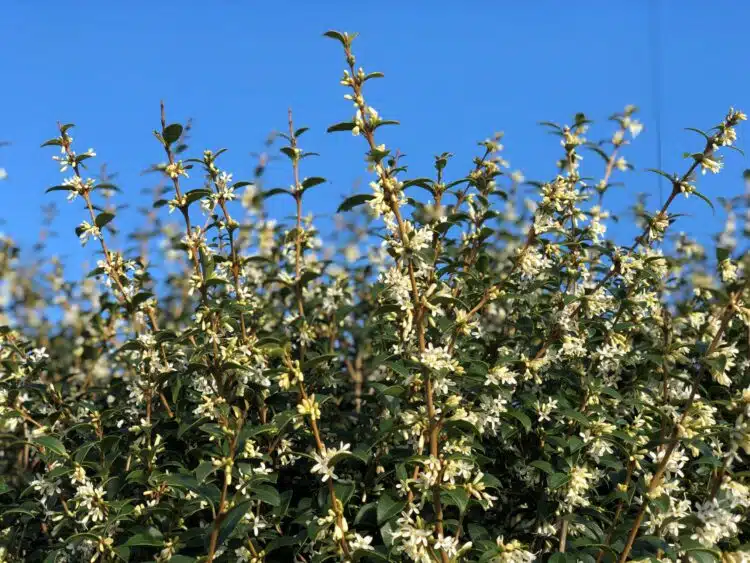 https://www.hopesgrovenurseries.co.uk/wp-content/uploads/2024/02/IMG_0478-750x563.jpg
https://www.hopesgrovenurseries.co.uk/wp-content/uploads/2024/02/IMG_0478-750x563.jpg
Every garden’s got a boundary or two and it doesn’t necessarily have to have a formal hedge, because regular clipping normally reduces flower and fruit. If you use a mixed planting of ornamental shrubs instead, it’s less maintenance and you’ll get insect-friendly flowers and possibly fruit as well. This will add diversity to you plot and help nature along the way, because growing a wider range of plants in your garden will attract more wildlife. Birds may nest, bees and other pollinators will visit and many an insect will shelter.
If you use deciduous plants, the woody canopy will allow light though once the leaves fall. In winter the woody roots will help to drain the soil, allowing you to underplant with easily grown spring woodlanders such as pulmonarias, primroses, hardy ferns and hybrid hellebores. The overhead canopy of branches will protect the ground from the worst of the weather, be it drought, frost or heavy rain. More importantly, woody plants provide a winter framework, just when many plants have retreated underground. Their presence adds another element to your garden – structure.
Flower Power on the Edge
Garden edges don’t tend to get quite as much attention as the rest, if my garden’s anything to go by, so you need to select easy shrubs that don’t need special treatment. Ornamental elders, or Sambucus, are a perfect addition because they offer domed flowers in summer and black foliage and berries in winter. ‘Black Lace’ (syn. ‘Eva’) and it’s sibling ‘Black Beauty’ (syn. ‘Gerda’) have dusky elaborate foliage and pale-pink flowers that are favoured by hoverflies.
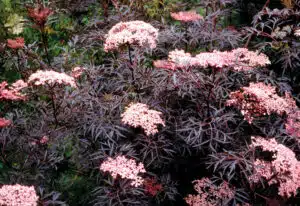
They were both rescued from a field at East Malling Research Centre in Kent, a mere 25 miles north of Hopes Grove Nursery, some thirty years ago. A research scientist named Ken Tobutt set about examining gene flow using a mixture of traditional and modern techniques. He planted out a field of seedlings and planned to uproot them onto the compost heap at the end of the experiment. However, the dark foliage and pink flowers of ‘Black Lace’ and ‘Black Beauty’ were thought too good to dispose of so the research station registered them. ‘Black Lace’ became the star plant at the Chelsea Flower Show of 2003 and it’s still a star performer twenty years on.
These dusky ornamental elders make excellent additions to a summer border of perennials, because the domed pink flowers slot into summer’s pastel palette with ease. The dark foliage creates a contrast and it’s particularly useful at highlighting pale-brown grasses, such as miscanthus. Black Lace’ has more-divided foliage than ‘Black Beauty’, but both were awarded the prestigious AGM by the RHS.
The dark elder foliage would look sensational next to the late-spring flowers of the snowball tree, Viburnum opulus ‘Roseum’. And this is one shrub I prefer in bud, because the sterile florets are a cool, jade-green. They shine next to the darker green foliage, capturing the freshness of an early-May day. As the rounded flowers open, they turn white and then cream before developing a rose-pink hue, hence the name ‘Roseum’. The flowers of this large shrub also cut well, so it’s a floral favourite with flower arrangers.
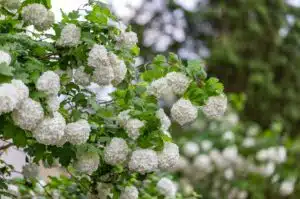
As summer days arrive you could experience the lemon-scent of a mock orange named Philadelphus ‘Belle Étoile’. This is my favourite Philadelphus, because each single white flower has a soft-purple blotch framing a boss of pale-yellow stamens. This arrangement stops the flowers from looking glacial and, as many a gardener will tell you, clear-white is the most difficult colour to deal with under summer sun. if you do use add plenty of green foliage, or place it in dappled shade to soften it.
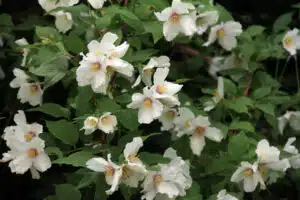
‘Belle Étoile’ is a well-behaved, man-high shrub bearing plenty of flower. Like all mock oranges it will tolerate poor, dry soil, so it’s likely to thrive in the drier summers we’re tending to get now. It will need some pruning after flowering. Remove a third of the older growth back to emerging buds, using secateurs. Don’t be tempted to trim this one into a roundel with shears, because this summer sensation relies on developing elegant long branches that curtsy under the weight of flower.
It’s important to have some early performers on the edge too and the ubiquitous, upright Viburnum x bodnantense ‘Dawn’ will provide flowers from late-autumn until March or April. The small clusters of pink flowers are highly fragrant during November, when they bear a strong hyacinth scent. They continue to flower once the leaves fall, whenever the weather is warm enough, ending in a final spring flourish. This shrub doesn’t do a razzle dazzle, sock-it-to-you display. It just drip feeds the flowers in, whenever the weather allows. Subtlety in motion.
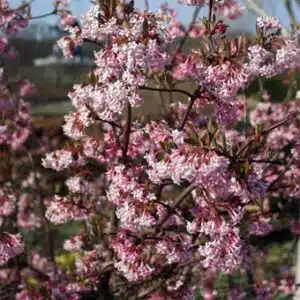
Winter Honeysuckle (Lonicera fragrantissima) will always give some January flower in milder winters. The small, ivory-white flowers sustain early-flying honeybees, so this will need pruning in early spring, otherwise you’ll be cutting off latent flower buds. The spring-flowering Prunus incisa ‘Kojo-no-Mai’ flowers by April, after the worst of the weather is over. This dwarf form of the Fuji Cherry has divaricate or twisted branches, so it’s an interesting bonsai-shaped shrub when the leaves are off.
Once spring arrives, thousands of buds open and smother the branches with pale-pink flowers so it’s not surprising that the Japanese name translates as ‘flight of butterflies’. It’s slow-growing, only reaching 4m after many years, and it’s long-lived and rarely needs pruning. However, it does need a bright spot to flower well. It’s also a fabulous container plant, accompanied by rich-blue muscari or the blue wood anemone ‘Robinsoniana’.
I’d also add Abelia x grandiflora, because it provides late-summer autumn flower. There are variegated forms, such as ‘Confetti’ and ‘Kaleidoscope’, but the plain-green leafed form sets off the clusters of pink buds and pale-peach flowers really well. If you do go for a variegated form, cut away any shoots that revert back to plain-green.
You can’t fail to notice the cinnamon-brown stems too, a feature of this twiggy shrub in winter. It is drought-tolerant so add it to the sunnier side of your ‘on-the-edge’ planting and it will reward you with an abundance of flower. Prune in early spring, if needed.
Flowers amid Foliage
Although I love the charcoal sketch winter provides, with its black and white theme, you need some evergreen structure as well. Bear in mind that evergreens tend to be less hardy than deciduous plants, so they may need a more sheltered site away from northerly and eastern boundaries. In the wild, they are often understorey plants, so they will tolerate some shade in the garden setting.
Everyone, in my opinion, should have the brilliantly architectural Mahonia x media ‘Winter Sun’ for its November flowers. Each gently arching stem is topped by a radiating cluster of pale-yellow fingers of fragrant flower underpinned by prickly foliage. It can tolerate quite a lot of shade and still flower well, although the architectural framework needs space to shine. When planting a boundary edge, position your plants a metre away if that’s possible.
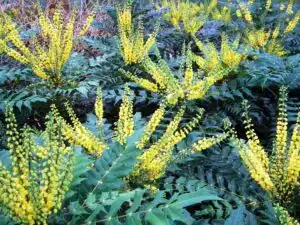
‘Charity’, another very similar named form, came from the same 1950s seed batch from the long-gone, Northern Irish nursery named Slieve Donard. Some of the seedlings were passed on to another nursery, Messrs L. R. Russell’s Richmond Nursery in Surrey. Sir Eric Savill, creator of the woodland garden in Windsor Great Park, planted some of them and one really stood out. Russell’s Nursery gave it the ‘tongue-in-cheek’ name of Charity’, because the Slieve Donard Nursery didn’t get any reward from the terrific seedling they’d given away so lightly.
In 1984 the nursery’s owner Lesley Slinger tried to redress the balance by naming his own seedling ‘Winter Sun’. This has brighter yellow, slightly earlier flowers and some think it better than ‘Charity’. Very few other plants produce fragrant flowers in November, but Eleagnus x submacrophylla ‘Limelight’ has tiny vanilla-scented flowers. The golden leaves are irregularly margined in green so it’s well named because it does light up the garden during the dank winter months. It does need a warm site and good drainage in order to thrive. It can also tolerate maritime conditions and, if it’s happy, it whizzes along.
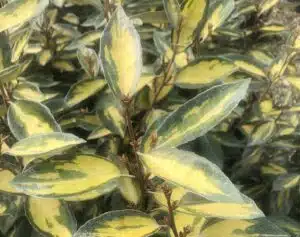
You’ll also get a sweet perfume from the ivory-white flowers of Osmanthus x burkwoodii, a large evergreen shrub capable of flowering in relatively shady areas. The privet-like green foliage and clusters of tubular white flowers, evenly spaced along cinnamon-brown stems, are a compensation in early spring. It will flower earlier in a brighter position and many add some snowdrops at the base. There are other excellent shrubs bearing the Burkwood name, because brothers Arthur (1888-1951) and Albert Burkwood (b. 1890) ran the Park Farm Nursery at Kingston upon Thames.
It’s important to find a sunny, clement position for Viburnum tinus ‘Eve Price’, a more-compact evergreen laurustinus, with pink buds and white flowers. It’s said to be hardier in constitution than some others, but all of them provide a long-lasting presence because the flowers open in sequence during winter and spring.
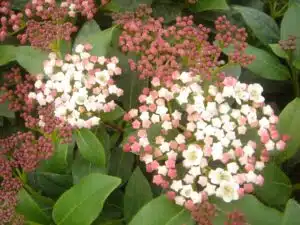
If you have a sheltered side to your boundary and enough space for a billowing, flowering evergreen, Mexican orange blossom, or Choisya ternata, will produce most of its white flowers in spring, followed by an autumnal flush. This shrubby member of the Rue family has aromatic foliage, always an indication that sunlight is preferred. After all, that oily aromatic coating is plant sunscreen. The pungent foliage deters rabbits and deer, but this luxuriant shrub needs warmth. Find it the sunniest spot along your boundary.
Pleached trees are a garden-design favourite, because they provide an instant leafy screen that looks stylish as soon as it’s planted. They offer privacy for you and they help to muffle noise and that’s becoming more important in our busy world. They provide a living screen that’s far more eco-friendly than a stark wooden fence…
Green is such an important colour in the garden. In winter it provides warmth and reassurance, like a beating heart ticking away while the rest of the garden slumbers. In summer, it’s the complete opposite. Rich-green cools and soothes the garden and the gardener alike, acting as a backdrop or shade caster. The rich foliage…
Gardeners are nurturers by nature: it goes with the job description! We care for plants and, hopefully, they grow for us. We’re also in tune with nature, simply because we’re outside an awful lot. When we’re looking at our plants, we notice the spiders, the bees and the butterflies. They are the living layer: the…